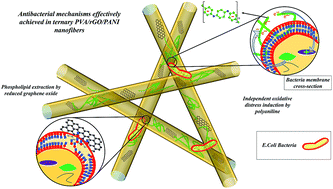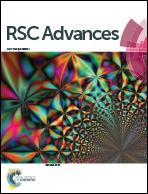PVA/PANI/rGO ternary electrospun mats as metal-free anti-bacterial substrates†
Abstract
Successful performance of biocompatible hybrid systems in various biomedical applications such as wound healing patches, and scaffolds for stem cell preparation have been reported. However, relatively poor structural properties and further bacterial infection have been the major drawbacks for their commercialization. In order to improve the antimicrobial property of such structures, transition metals have been previously added to the media. However, the potential risk of metal pollution as well as hardship of processing has put this approach into obsolescence. Herein the ternary polyvinyl alcohol/reduced graphene oxide/polyaniline fibrous nanocomposites, as substitute for transition metal-containing nanocomposites, were prepared via electrospinning. The mats' structural properties (e.g. rheological, morphological, electrical and mechanical properties) and their antibacterial properties against E. coli bacteria cultures after two different treatments (including thermal and acid doping approaches) were systematically investigated. It was shown that in addition to significant structural improvement, an over 80% antibacterial property enhancement in treated mats in comparison to pristine PVA fibers were achieved. Finally the interaction and main effect analyses were used for suggesting the optimum antibacterial specimen conditions.


 Please wait while we load your content...
Please wait while we load your content...